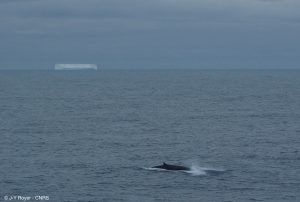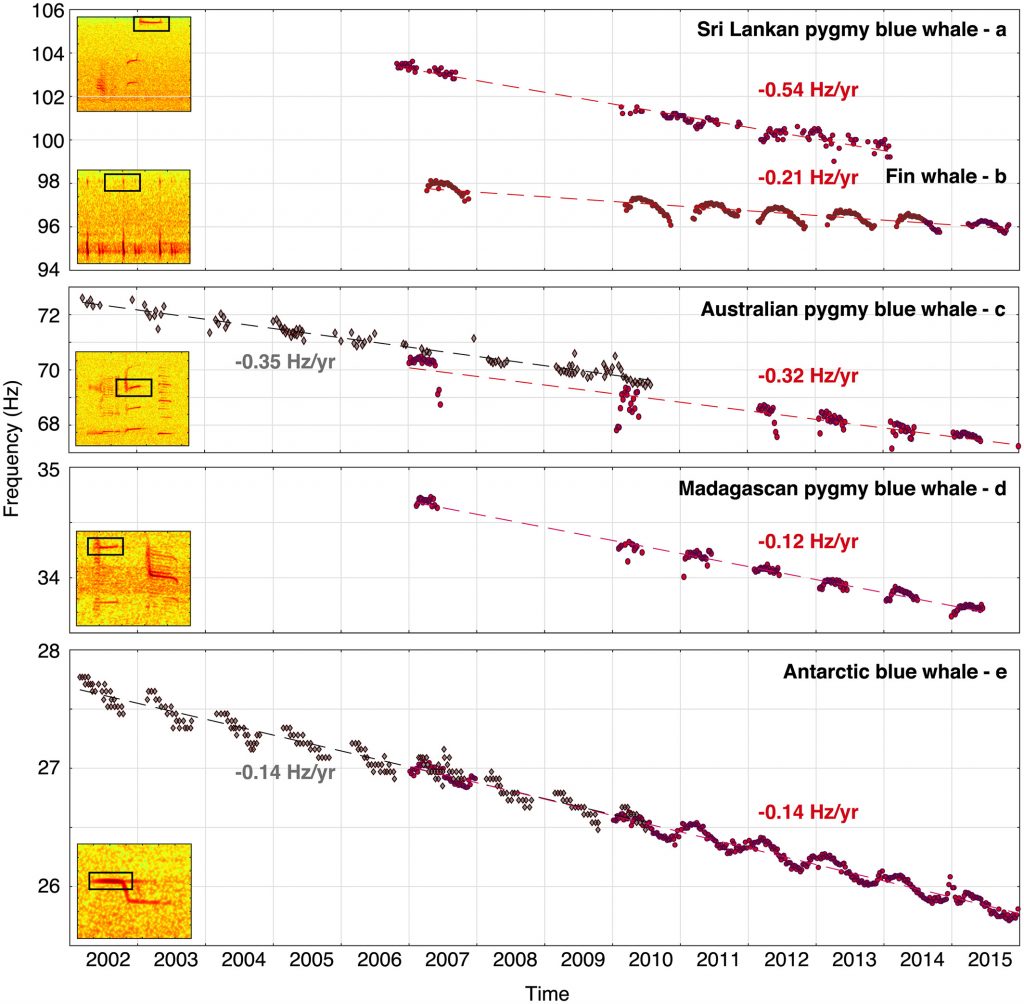28 November 2018

A fin whale surfaces at 58˚S in the southern Indian Ocean in a photo captured in January 2010 from the R/V Marion Dufresne, the research vessel that collected hydrophone data for the new study.
Credit: J-Y Royer
WASHINGTON— Blue whales around the world are singing a little flat, and scientists may now have more clues as to the reason why.
A new study finds there’s a seasonal variation in the whales’ pitch correlated with breaking sea ice in the southern Indian Ocean. The new research also extends the mysterious long-term falling pitch to related baleen whales and rules out noise pollution as the cause of the global long-term trend, according to the study’s authors.
Blue and fin whales are among the loudest animals in the oceans as well as the largest. Only males sing, humming about as loud as large ships. The whales’ loud songs can travel more than 1,000 kilometers (600 miles) underwater, allowing the whales to communicate across vast oceans.
Blue whales have been dropping pitch incrementally over several decades, but the cause has remained a mystery. Now, the new study in AGU’s Journal of Geophysical Research: Oceans finds the same mysterious long-term trend of falling pitch in fin whales and Madagascan pygmy blue whales. Pitch, or the perception of how high or low a note sounds, is a result of the frequency of the sound wave, usually measured in hertz.
The authors of the new study use new data from the southern Indian Ocean to rule out noise pollution as the cause of the pitch change. Instead, the new study suggests the pitch drop is an anatomical consequence of singing less loudly. The whales’ calls could be quieter due to growing numbers of whales or changes in the ocean due to climate change, according to the study’s authors.
“We think it is something non-voluntary from the whale. Decrease the call intensity and it will decrease the call frequency, just because of the sound emission mechanism,” said Emmanuelle Leroy, lead author of the new study and a research fellow at the University of New South Wales in Australia.
The new research also uncovers a seasonal counterpoint in the calls of Antarctic blue whales, potentially related to the noise of melting sea ice. The new study finds blue whale calls in the southern Indian Ocean increase in pitch during the summer. The pitch could be increasing as whales sing louder to be heard over breaking sea ice, according to the study’s authors.
“Our hypothesis is that the call frequency change is again linked to call intensity and that the whale will adapt the call intensity to the variation of noise level,” Leroy said. “The noise is related to the increasing number of free icebergs in summer. When the ice sometimes cracks, like when you put ice in your drink, it makes noise. This noise is really strong and will propagate over really long distances, so we can hear this noise at our northernmost site, up to 26 degrees south.”
Analyzing whale songs
The new study analyzed more than 1 million songs from three species of large baleen whale: fin, Antarctic blue and three acoustically-distinct populations of pygmy blue whales. Six stationary underwater microphones recorded the calls over six years, from 2010 to 2015, in the southern Indian Ocean, an area spanning 9 million square kilometers (3.5 million square miles).
The stereotypical song of the Antarctic blue whale spans about 15 to 30 hertz, at the very bottom edge of human hearing, which ranges from about 20-20,000 hertz. Blue whale songs are in the range of the lowest, longest pipes of large cathedral organs. For consistency, the study measured the pitch of selected elements of each species’ song, which had fallen to about 25.6 hertz for the Antarctic blue and 96 hertz for the fin whale by the end of 2015.
In 2002, the pitch of the selected element of the blue whales’ call was closer to 27.5 hertz, a difference from the 2015 values equivalent to about a whole tone or major second interval in Western music tradition.
The new study found Antarctic blue whale calls are falling 0.14 hertz per year. Though fin whales, pygmy blue whales and Antarctic blue whale sing very different songs, the new study observed similar trends in call pitch, falling about 0.12 to 0.54 hertz per year, depending on the species.

Fin and blue whale call frequencies have declined in the southern Indian Ocean during the period of monitoring, from 2002 to 2015. Datapoints are weekly averaged peak frequencies measured for selected units in the calls. Red points are data from the new study. Black diamonds are data digitized from previously published work. The rates of frequency decrease in hertz per year are the slopes of the fitted dashed lines. Figure reproduced from the new study.
Credit: JGR-Oceans/AGU
The new research also found whale calls rise in pitch by 0.2 – 0.3 hertz from October through February.
Low pitches carry farther underwater, but the pitch change is likely too small to make a difference in the way the whale calls travel over long distances in the ocean and too subtle for the whales to detect any changes, according to the study’s authors
Changing soundscape
Unlike most of the world’s oceans, subject to an increasing mechanical cacophony, the southern Indian Ocean has grown quieter in recent years and its shipping traffic is limited.
Because the long-term trends in pitch drop are steady around the global range of the whales, the data from the Indian Ocean indicates the ongoing drop cannot be explained as a response to human-generated noise. Instead, the authors of the new study suggest the drop could be a byproduct of lower volume if the rebounding whale population doesn’t need to sing as loudly to reach other whales.
Recent population assessments estimate there are 10,000 to 25,000 blue whales globally, up from a few thousand at the end of commercial whaling in the 1970s, but still fewer than 10 percent of their numbers before the 20th century.
“Because the whaling stopped, the whale population is increasing. They can decrease their call intensity to keep in touch, because there are more whales. These calls are long distance communication,” Leroy said.
Alternatively, Leroy said, the whales may not need to be so loud because sound travels farther in ocean water made increasingly acidic by climate change. The speed and distance sound travels are affected by the temperature, pressure and chemistry of the ocean.
Naturally-occurring seasonal ocean noise could explain the seasonal variation in whale call pitch observed by the researchers in the southern Indian Ocean, however.

Whale song pitch, ambient underwater noise and icebergs: the blue line traces seasonal changes in the pitch, or audio frequency, of blue whale calls. The red trend traces rising and falling ambient noise and the blue histograms show the number of free icebergs per week. This figure from the new study outlines the seasonal correlation between the occurrence of icebergs, the increase in the noise level, and the shift in the blue whales’ “Z‐call” frequency.
Credit: JGR-Oceans/AGU
They observe the seasonal variation in pitch during the months of the austral summer when sea ice breaks up. Iceberg crackles are loud. They boom for thousands of kilometers in a frequency range overlapping the pitch of the Antarctic blue whales’ calls. To be heard over the noise the whales may need to get a little louder, the study suggests. Singing louder makes the pitch go up.
“What’s surprising is the long-term and short-term changes could have the same reason, a change in call intensity, but the change responds to two different causes,” Leroy said.
###
The American Geophysical Union is dedicated to advancing the Earth and space sciences for the benefit of humanity through its scholarly publications, conferences, and outreach programs. AGU is a not-for-profit, professional, scientific organization representing 60,000 members in 137 countries. Join the conversation on Facebook, Twitter, YouTube, and our other social media channels.
Notes for Journalists
This paper will be open access until December 30. Journalists and public information officers (PIOs) can download a PDF copy of the article by clicking on this link:
https://agupubs.onlinelibrary.wiley.com/doi/pdf/10.1029/2018JC014352
Multimedia accompanying this press release can be downloaded here:
https://aguorg.sharepoint.com/:f:/s/newsroom/EoBilhlJ1fBAoEe_sCL9B50B7O3_ZxAlLwYInP2BCxAW4Q
Journalists and PIOs may also request a copy of the final paper and multimedia by emailing Liza Lester at [email protected]. Please provide your name, the name of your publication, and your phone number.
Neither the paper nor this press release is under embargo.
“Long-term and seasonal changes of large-whale call frequency in the southern Indian Ocean”
Authors:
Emmanuelle Leroy: currently at the University of New South Wales, Sydney, Australia;
study carried out at the University of Brest & French National Centre for Scientific Research (CNRS), Geosciences Ocean Lab, Plouzané, France
Jean-Yves Royer: University of Brest & French National Centre for Scientific Research (CNRS), Geosciences Ocean Lab, Plouzané, France
Julien Bonnel: Woods Hole Oceanographic Institution, Woods Hole, Massachusetts
Flore Samaran: ENSTA Bretagne & French National Centre for Scientific Research (CNRS), Lab-STICC, Brest, France
Contact information for the authors:
Emmanuelle Leroy (Australia): [email protected], +61 457 445 438 (Sydney time = UTC +11 hours)
Jean-Yves Royer (France): [email protected], + 33 (0)2 98 49 87 67 (Plouzané time = UTC + 1 hour)
Liza Lester
+1 (202) 777-7494
[email protected]

